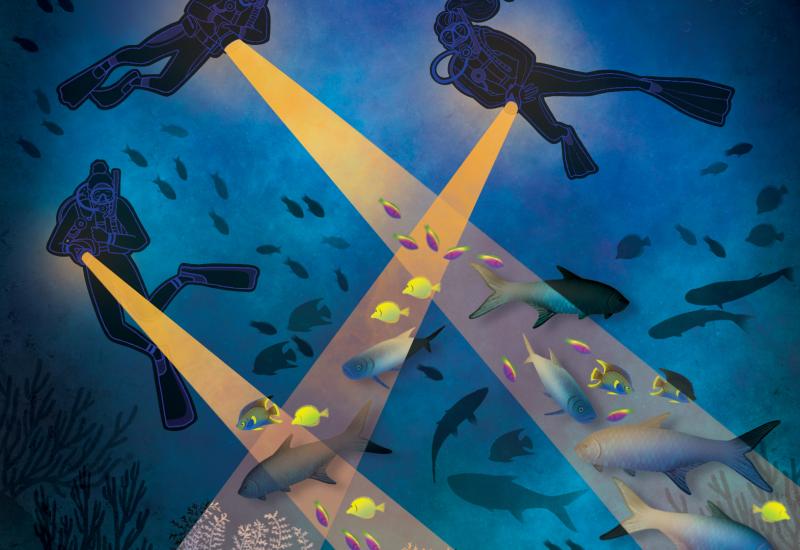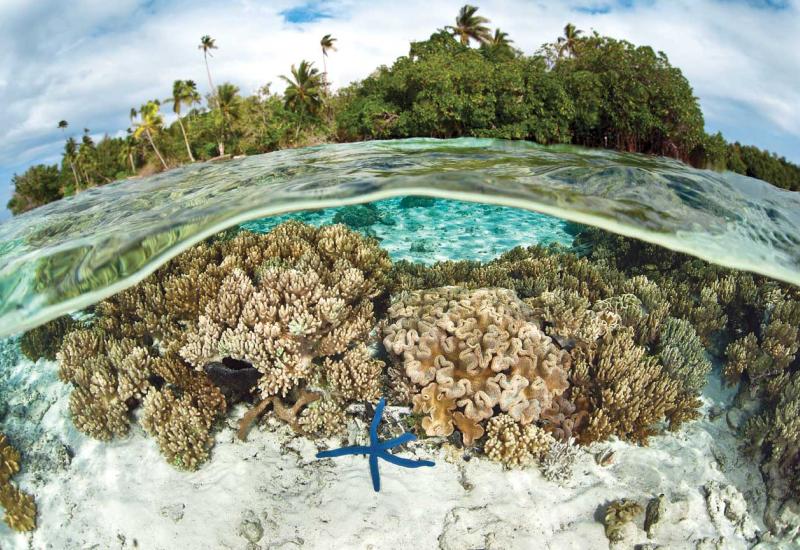The New Caribbean - Tobago - The Sisters

The Sisters
Mention Tobago to divers and most who know about this tiny island will immediately say, “Ah, the drift-dive capital of the Caribbean.” This is true, but there’s far more to Tobago than the superlative current-riding opportunities out of Speyside on the northeast coast, where you can fly like a bird past enormous brain corals — including one reputed to be the largest in the world — on sites such as Kelleston Drain, Flying Manta and Bookends. This popular Caribbean isle has a secret: On the lesser known northwest coast, you can regularly encounter hammerheads — both scalloped and the much larger great hammerhead — at a peculiar site called the Sisters. While the southern Caribbean isn’t considered a hotbed of shark activity, the Sisters bucks the trend. About two miles offshore, just north of Bloody Bay, a cluster of five rocky pinnacles rise up from 130 feet, attracting hammerheads with astounding frequency. Around the base of the pinnacles are large boulders and rocks, which have sand chutes running between and around them, and the hammerheads can be found cruising in this particular area. Due to its location, the Sisters is often subject to strong currents, large swells and unpredictable weather patterns, making it suitable only for experienced divers not averse to dropping to the limits of recreational diving and coming into close contact with big pelagic fish. These conditions can render the Sisters undivable at times, but if you are lucky enough to choose a day when it’s all systems go, you’re in for the dive of your life. — Mark Evans
Need to Know
Getting There: American Airlines flies to Trinidad twice daily from Miami, and Continental from Newark and Houston. Caribbean Airlines (formerly BWIA) also operates from various U.S. airports, including Miami and New York. From Trinidad, several airlines offer connections to Tobago. When to Go: December through March holds the greatest chance for hammerhead sightings. Dive Conditions: Average water temp is 78°F, with visibility from 60 to 80 feet. Strong currents and large swells are common at the Sisters, so you’ll need to be patient and an experienced diver. Operator/Accommodations: Tobago Dive Experience (www.tobagodiveexperience.com) operates out of the Manta Lodge (www.mantalodge.com) in Speyside, offering access to both the world-renown drift diving and the hammerheads of the Sisters. Inside Tip: Don’t miss a visit to Jemma’s treehouse restaurant in Speyside for traditional island cooking and healthy-sized portions with a stellar view.

The Sisters
Mention Tobago to divers and most who know about this tiny island will immediately say, “Ah, the drift-dive capital of the Caribbean.” This is true, but there’s far more to Tobago than the superlative current-riding opportunities out of Speyside on the northeast coast, where you can fly like a bird past enormous brain corals — including one reputed to be the largest in the world — on sites such as Kelleston Drain, Flying Manta and Bookends. This popular Caribbean isle has a secret: On the lesser known northwest coast, you can regularly encounter hammerheads — both scalloped and the much larger great hammerhead — at a peculiar site called the Sisters. While the southern Caribbean isn’t considered a hotbed of shark activity, the Sisters bucks the trend. About two miles offshore, just north of Bloody Bay, a cluster of five rocky pinnacles rise up from 130 feet, attracting hammerheads with astounding frequency. Around the base of the pinnacles are large boulders and rocks, which have sand chutes running between and around them, and the hammerheads can be found cruising in this particular area. Due to its location, the Sisters is often subject to strong currents, large swells and unpredictable weather patterns, making it suitable only for experienced divers not averse to dropping to the limits of recreational diving and coming into close contact with big pelagic fish. These conditions can render the Sisters undivable at times, but if you are lucky enough to choose a day when it’s all systems go, you’re in for the dive of your life. — Mark Evans
Need to Know
Getting There: American Airlines flies to Trinidad twice daily from Miami, and Continental from Newark and Houston. Caribbean Airlines (formerly BWIA) also operates from various U.S. airports, including Miami and New York. From Trinidad, several airlines offer connections to Tobago. When to Go: December through March holds the greatest chance for hammerhead sightings. Dive Conditions: Average water temp is 78°F, with visibility from 60 to 80 feet. Strong currents and large swells are common at the Sisters, so you’ll need to be patient and an experienced diver. Operator/Accommodations: Tobago Dive Experience (www.tobagodiveexperience.com) operates out of the Manta Lodge (www.mantalodge.com) in Speyside, offering access to both the world-renown drift diving and the hammerheads of the Sisters. Inside Tip: Don’t miss a visit to Jemma’s treehouse restaurant in Speyside for traditional island cooking and healthy-sized portions with a stellar view.

The Sisters
Mention Tobago to divers and most who know about this tiny island will immediately say, “Ah, the drift-dive capital of the Caribbean.” This is true, but there’s far more to Tobago than the superlative current-riding opportunities out of Speyside on the northeast coast, where you can fly like a bird past enormous brain corals — including one reputed to be the largest in the world — on sites such as Kelleston Drain, Flying Manta and Bookends. This popular Caribbean isle has a secret: On the lesser known northwest coast, you can regularly encounter hammerheads — both scalloped and the much larger great hammerhead — at a peculiar site called the Sisters. While the southern Caribbean isn’t considered a hotbed of shark activity, the Sisters bucks the trend. About two miles offshore, just north of Bloody Bay, a cluster of five rocky pinnacles rise up from 130 feet, attracting hammerheads with astounding frequency. Around the base of the pinnacles are large boulders and rocks, which have sand chutes running between and around them, and the hammerheads can be found cruising in this particular area. Due to its location, the Sisters is often subject to strong currents, large swells and unpredictable weather patterns, making it suitable only for experienced divers not averse to dropping to the limits of recreational diving and coming into close contact with big pelagic fish. These conditions can render the Sisters undivable at times, but if you are lucky enough to choose a day when it’s all systems go, you’re in for the dive of your life. — Mark Evans










